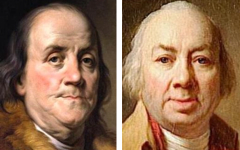Peale’s The Artist in His Museum (1822)

Charles Willson Peale, The Artist in His Museum (1822) Oil on canvas. Pennsylvania Academy of the Fine Arts, Philadelphia.
Click image to enlarge.
Charles Willson Peale, an important American artist who bridged the 18th and 19th centuries, depicted himself in old age lifting a curtain to reveal his newly-opened gallery in Philadelphia. It was the first public museum in the United States and exhibited paintings alongside specimens of natural history such as the partly-hidden skeleton of a mastodon. And while this picture is clearly promotional and self-promotional, it is also poetic using themes and methods that have been central to art for many centuries. Among them are the androgynous and fertile nature of the creative mind, the pursuit of ageless wisdom and the associated symbolism of the female breast which, though well-hidden here, is crucial to its meaning.
Click next thumbnail to continue

Detail of Peale's The Artist in His Museum showing a female breast in the contour of his coat
Click image to enlarge.
Adam Brown, first a reader and now a contributor to EPPH, has cleverly identified Peale’s coat, its lone button in silhouette, as the soft curve of a giant female breast with the artist, so to speak, inside it. (Paul Cézanne made the same association in another self-portrait.) Male poets from at least the Renaissance onwards have often compared their creative conceptions to a woman's fertile body and have also stressed that a poetic mind must be androgynous to be universal. Peale also puns because the jacket from which the breast is formed is a breast coat, perhaps even single-breasted.
Click next thumbnail to continue

Two diagrams of Peale's The Artist in His Museum showing the location of a second breast-shape
Click image to enlarge.
Another mamillary form is present in miniature within the negative space of the bench's leg directly beneath the larger “breast”. Peale, a Freemason, would have believed in the mystical ascent in which the individual after long trial controls his or her ego and becomes at one with God. Perhaps that is why the small breast is bathed in light pointing upwards. Significantly too, the bench's shadow is illogical, especially the two long parallel lines for the leg. Note also how the shadow of its length resembles a bulky male figure with arms seemingly extended in a cruciform reflection of the artist's figure. Admittedly, one "arm" is mostly hidden. The artist-as-Christ is a common feature of canonical work and would represent the hidden unity with God or Being that Freemasons and other strains of the Inner Tradition have always sought.
Click next thumbnail to continue

Detail of Peale's The Artist in His Museum with, inset, a 19th-century illustration of mastodon teeth
Click image to enlarge.
We now turn to another breast-related element, the reconstructed skeleton of the museum's prize exhibit partly hidden behind the curtain. Excavated under Peale's direction it is accompanied by the jaw and teeth of another mastodon in the right foreground with a large limb behind. As Adam informed me, the mastodon is named after its bulbous, breast-like teeth, some of which even have a nipple-form on top (see inset). Masto- is the Greek root for breast and don[t] for tooth. It is also worth noting how the accumulation of similarly-themed motifs within this painting makes the less obvious references more convincing. This is also true of how the spiritual message is conveyed.
Click next thumbnail to continue
Finally the gold-framed portraits at the top suggest that unity with the divine, symbolized by gold, is an ascent. The portraits, though, are male so Peale who believed in the androgyny of pure minds clothed the woman, the largest visitor, in gold as well. As an alter ego, her feet are in the same position as Peale's as she stares at both the ancient mammal and, perhaps, the source of the Christomorphic shadow on the floor. Spiritual knowledge, as in Freemasonry, is unveiled slowly which is why Peale, punning again, peels back our view of his "painting" behind. [For more on Insight-Outsight, see note 1.)1 He is thus artist, showman, businessman and spiritual guide.
And, remember, you don't have to be expert to see what is hidden. Anyone familiar with our universal themes can do it for themselves, as Adam did here.
More Works by Peale, Charles Willson
Notes:
1. The red velvet curtain is again shaped into a breast-form, somewhat like a bra or bikini-top. However, the two large red "breasts" also represent the artist's inner eyes, a form of double-symbolism common in art, here suggesting, once more, the fertlity of the artist's visual imagination. The shadowed folds of the hanging curve on the right resemble an open eye with a pupil in the center while the other "eye" seems partly closed, its "eyelid" lowered. They are yet another example of an artist's two types of vision explained under the theme Insight-Outsight. Yet, as always, if we want to advance and fulful our potential as a human being, we too must become like an artist, looking both inwards at who we really are and outwards at nature.
Original Publication Date on EPPH: 30 Jun 2016. © Simon Abrahams. Articles on this site are the copyright of Simon Abrahams. To use copyrighted material in print or other media for purposes beyond 'fair use', you must obtain permission from the copyright owner. Websites may link to this page without permission (please do) but may not reproduce the material on their own site without crediting Simon Abrahams and EPPH.



